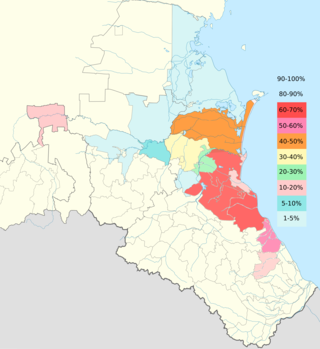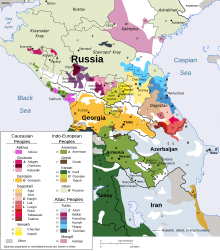
A | B | C | D | E | F | G | H | CH | I | J | K | L | M | N | O | P | Q | R | S | T | U | V | W | X | Y | Z | 0 | 1 | 2 | 3 | 4 | 5 | 6 | 7 | 8 | 9
| Kumyk | |
|---|---|
| къумукъ тил qumuq til • قموق تیل | |
 | |
| Native to | North Caucasus |
| Region | Dagestan, Chechnya, North Ossetia |
| Ethnicity | Kumyks |
Native speakers | 450,000 (2010 census)[1] |
Turkic
| |
| Cyrillic, Latin, Arabic | |
| Official status | |
Official language in | Dagestan (Russia) |
| Language codes | |
| ISO 639-2 | kum |
| ISO 639-3 | kum |
| Glottolog | kumy1244 |
 Share of the Kumyk population in areas of traditional residence in the Caucasus according to the 2010 census | |

| External videos | |
|---|---|
A series of videos about the similarities of languages | |
Kumyk (къумукъ тил,[2] qumuq til,[3] قموق تیل[4][5]) is a Turkic language spoken by about 426,212 people, mainly by the Kumyks, in the Dagestan, North Ossetia and Chechen republics of the Russian Federation.[6] Until the 20th century Kumyk was the lingua-franca of the Northern Caucasus.
Classification
Kumyk language belongs to the Kipchak-Cuman subfamily of the Kipchak family of the Turkic languages. It's a descendant of the Cuman language, with likely influence from the Khazar language,[7] and in addition contains words from the Bulghar and Oghuz substratum.[7] The closest languages to Kumyk are Karachay-Balkar, Crimean Tatar, and Karaim languages.[8]
Nikolay Baskakov, based on a 12th-century scripture named Codex Cumanicus, included modern Kumyk, Karachai-Balkar, Crimean Tatar, Karaim, and the language of Mamluk Kipchaks in the linguistic family of the Cuman-Kipchak language. Samoylovich also considered Cuman-Kipchak close to Kumyk and Karachai-Balkar.[9]
Amongst the dialects of the Kumyk there are Kaitag, Terek (Güçük-yurt and Braguny), Buynaksk (Temir-Khan-Shura) and Xasavyurt. The latter two became basis for the literary language.[10]
History
Kumyk had been a lingua-franca of the bigger part of the Northern Caucasus, from Dagestan to Kabarda, until the 1930s[11][12][13] and was an official language of communication between the North-Eastern Caucasian nations and the Russian administration.[14]
In 1848, a professor of the "Caucasian Tatar" (Kumyk) Timofey Makarov published the first ever grammatical book in Russian language for one of the Northern Caucasian languages, which was international Kumyk. Makarov wrote:[15]
From the peoples speaking Tatar language I liked the most Kumyks, as for their language's distinction and precision, so for their closeness to the European civilization, but most importantly, I take in account that they live on the Left Flank of the Caucasian Front, where we're conducting military actions, and where all the peoples, apart from their own language, speak also Kumyk.
More than 90% of the Kumyks, according to 2010 census, also speak Russian, and those in Turkey and the Levant speak Turkish and Arabic.[citation needed]
Phonology
| Front | Back | |||
|---|---|---|---|---|
| Close | i ⟨и⟩ | y ⟨уь⟩ | ɯ ⟨ы⟩ | u ⟨у⟩ |
| Mid | e ⟨e⟩ | ø ⟨оь⟩ | o ⟨o⟩ | |
| Open | æ ⟨ә⟩ | a ⟨a⟩ | ||
| Labial | Dental | Palatal | Velar | Uvular | Glottal | ||
|---|---|---|---|---|---|---|---|
| Nasal | m ⟨м⟩ | n ⟨н⟩ | ŋ ⟨нг⟩ | (ɴ) ⟨нг⟩ | |||
| Plosive/ Affricate |
voiceless | p ⟨п⟩ | t ⟨т⟩ | tʃ ⟨ч⟩ | k ⟨к⟩ | q ⟨къ⟩[a] | |
| voiced | b ⟨б⟩ | d ⟨д⟩ | dʒ ⟨дж⟩ | ɡ ⟨г⟩ | (ɢ) ⟨къ⟩[a] | ||
| Fricative | voiceless | f ⟨ф⟩ | s ⟨c⟩ | ʃ ⟨ш⟩ | χ ⟨x⟩ | h ⟨гь⟩ | |
| voiced | β ⟨в⟩ | z ⟨з⟩ | ʒ ⟨ж⟩ | ʁ ⟨гъ⟩ | |||
| Liquid | rhotic | r ⟨p⟩ | |||||
| lateral | l ⟨л⟩ | ||||||
| Semivowel | j ⟨й⟩ | ||||||
- ^ a b къ represents at the beginning of words, and elsewhere (complementary distribution).[16]
Orthography
Kumyk has been used as a literary language in Dagestan and Caucasus for some time.[when?] During the 20th century the writing system of the language was changed twice: in 1929, the traditional Arabic script (called ajam) was first replaced by a Latin script, which was then replaced in 1938 by a Cyrillic script.
Latin based alphabet (1927–1937)

| A a | B b | C c | Ç ç | D d | E e | F f | G g |
| Ƣ ƣ | H h | I i | J j | K k | L l | M m | N n |
| Ꞑ ꞑ | O o | Ɵ ɵ | P p | Q q | R r | S s | Ꞩ ꞩ |
| T t | U u | V v | X x | Y y | Z z | Ƶ ƶ | Ь ь |
Cyrillic based alphabet (since 1937)
| А а | Б б | В в | Г г | Гъ гъ | Гь гь | Д д | Е е |
| Ё ё | Ж ж | З з | И и | Й й | К к | Къ къ | Л л |
| М м | Н н | Нг нг | О о | Оь оь | П п | Р р | С с |
| Т т | У у | Уь уь | Ф ф | Х х | Ц ц | Ч ч | Ш ш |
| Щ щ | Ъ ъ | Ы ы | Ь ь | Э э | Ю ю | Я я |
Comparison Chart
| Arabic alphabet 1921—1928 |
Latin 1928—1938 |
Cyrillic c 1938 |
Latin project 1991 |
IPA |
|---|---|---|---|---|
| ا | A a | А а | A a, Ä ä | /a/, /æ/ |
| ب | B ʙ | Б б | B b | /b/ |
| و, ۋ | V v | В в | V v, W w | /v/, ?pojem= |
| گ | G g | Г г | G g | /g/ |
| غ | Ƣ ƣ | Гъ гъ | Ğ ğ | /ʁ/ |
| ه | H h | Гь гь | H h | /h/ |
| د | D d | Д д | D d | /d/ |
| - | Je je, e | Е е | Ye ye, E e | |
| - | Ө ө | Ё ё | Yo yo, Ö ö | |
| ج, ژ | Ƶ ƶ, Ç ç | Ж ж | C c, J j | /d͡ʒ/, /ʒ/ |
| ز | Z z | З з | Z z | /z/ |
| ى | I i | И и | İ i | /i/ |
| ى | J j | Й й | Y y | /j/ |
| ک | K k | К к | K k | /k/ |
| ق | Q q | Къ къ | Q q | /q/ |
| ل | L l | Л л | L l | /l/ |
| م | M m | М м | M m | /m/ |
| ن | N n | Н н | N n | /n/ |
| نگ,ڭ | Ꞑ ꞑ | Нг нг | Ñ ñ | /ŋ/ |
| ۉ | O o | О о | O o | /o/ |
| ۊ | Ө ө | Оь оь | Ö ö | /ø/ |
| پ | P p | П п | P p | /p/ |
| ر | R r | Р р | R r | /r/ |
| س | S s | С с | S s | /s/ |
| ت | T t | Т т | T t | /t/ |
| و | U u | У у | U u | /u/ |
| ۏ | Y y | Уь уь | Ü ü | /y/ |
| ف | F f | Ф ф | F f | /f/ |
| خ | X x | Х х | X x | /x/ |
| تس | S̷ s̷ | Ц ц | Ts ts | |
| چ | C c | Ч ч | Ç ç | /t͡ʃ/ |
| ش | Ş ş | Ш ш | Ş ş | /ʃ/ |
| Щ щ | Şç şç | |||
| ء | ' | Ъ ъ | ' | /ʔ/, /ʕ/ |
| ى | Ь ь | Ы ы | I ı | /ɯ/ |
| Ь ь | ||||
| ه
Zdroj:https://en.wikipedia.org?pojem=Kumyk_language Text je dostupný za podmienok Creative Commons Attribution/Share-Alike License 3.0 Unported; prípadne za ďalších podmienok. Podrobnejšie informácie nájdete na stránke Podmienky použitia.
Analytika
Antropológia Aplikované vedy Bibliometria Dejiny vedy Encyklopédie Filozofia vedy Forenzné vedy Humanitné vedy Knižničná veda Kryogenika Kryptológia Kulturológia Literárna veda Medzidisciplinárne oblasti Metódy kvantitatívnej analýzy Metavedy Metodika Text je dostupný za podmienok Creative
Commons Attribution/Share-Alike License 3.0 Unported; prípadne za ďalších
podmienok. www.astronomia.sk | www.biologia.sk | www.botanika.sk | www.dejiny.sk | www.economy.sk | www.elektrotechnika.sk | www.estetika.sk | www.farmakologia.sk | www.filozofia.sk | Fyzika | www.futurologia.sk | www.genetika.sk | www.chemia.sk | www.lingvistika.sk | www.politologia.sk | www.psychologia.sk | www.sexuologia.sk | www.sociologia.sk | www.veda.sk I www.zoologia.sk |

